Attack aftermath: Army, RSF sweep Darfur’s Jebel Marra
The joint attacks by the Sudanese army and the paramilitary Rapid Support Forces (RSF) on Jebel Marra continued for the second day in a row today.
The joint attacks by the Sudanese army and the paramilitary Rapid Support Forces (RSF) on villages in Jebel Marra continued for the second day in a row today. The mainstream Sudan Liberation Movement led by Abdelwahid El Nur (SLM-AW) claims to have defeated a group of government troops near Guldo.
This morning, the government forces began sweeping villages north, west, and south of Fanga. Multiple villagers reported today that the government forces detained dozens of young men. The victims were humiliated, insulted with racist phrases, and “excessively beaten”.
Kaltoum Idris Nour (30), Emadeldin Haroun (35) years, and Seifeldin Yahya (40) were held in Seyonga village and taken to the military base of Fanga, one of the sources reported to Radio Dabanga.
 He added that Abdelrahim Adam Hamid (30) was killed and four women were gang-raped in the village of Dolo, five kilometres north of Fanga.
He added that Abdelrahim Adam Hamid (30) was killed and four women were gang-raped in the village of Dolo, five kilometres north of Fanga.
On Wednesday morning, two large forces of army soldiers and paramilitaries of the Rapid Support Forces (RSF), backed by intensive air bombardments, attacked a number of villages in Jebel Marra
One force attacked the area from the west, and the second one from the north-east. They used heavy artillery and missiles and were accompanied by intensive air raids, the villagers reported. At least six villagers were killed and injured.
The Sudanese government announced in October that its forces would “eliminate all rebel fighters during the next dry season”. Jebel Marra is a stronghold of the mainstream Sudan Liberation Movement (SLM-AW).
Rebel fighters
SLM leader Abdelwahid El Nur confirmed to Radio Dabanga today that a joint army-militia force with more than 270 vehicles and backed by tanks and Antonov aircraft attacked a number of villages in eastern and central Jebel Marra yesterday morning.
He said that one force, consisting of more than 170 vehicles, attacked the area from the west. The other force, consisting of 100 vehicles, came from the east.
According to the rebel chief, the bombing and shelling indiscriminately targeted villages east and west of Jebel Marra. He noted that the area of Debanyra was targeted, as well as Deribat, the villages of the El Aradeib unit, and the area east of Fanga.
“The attacks caused widespread destruction and the displacement of thousands of villagers from their homes,” he added.
El Nur further reported that SLM combatants managed to repel a group of government troops on their way to Guldo.
Villagers said that heavy fighting erupted between government forces and rebel fighters in the area of Rofta. The area was littered with dead bodies and burned vehicles.
The majority of the villagers sought refuge in the mountainous area southwest of Fanga, in particular the areas of Loga, Souna, and Jawa, the sources said. Many people, most of them women, children, and elderly, went missing in the heavy raids.
They renewed their appeal to the United Nations, the Security Council, and the international community “to intervene and rescue the people in Jebel Marra from those brutal attacks by Khartoum”.
Jebel Marra
The Jebel Marra massif lies in the centre of the Darfur region, bordering the state divisions of Central, South and North Darfur. It is a fertile region inhabited mainly by the Fur tribe and has since 2003 been the primary stronghold of the SLM-AW.
It is the only place in Darfur where armed opposition maintains prolonged control over territory and the only area in Darfur to which humanitarian organisations have had no access as of 2011.
Parts of the centre of the massif, the 'inner Jebel Marra area', are controlled by the Sudanese government and parts by the rebels.
Main obstacles to free and regular access to the area include restrictions by the parties to the conflict, preventing humanitarian organisations from entering both government and rebel-controlled areas.
According to the UN Office for the Coordination of Humanitarian Affairs (OCHA) in Sudan, there are about 365,000 people living in the greater Jebel Marra area. Approximately one third of them -95,000 people- live in the inner Jebel Marra.











 and then
and then